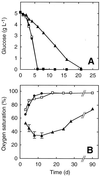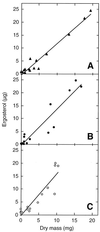Effect of culture conditions on ergosterol as an indicator of biomass in the aquatic hyphomycetes
- PMID: 11319080
- PMCID: PMC92835
- DOI: 10.1128/AEM.67.5.2051-2055.2001
Effect of culture conditions on ergosterol as an indicator of biomass in the aquatic hyphomycetes
Abstract
Ergosterol is a membrane component specific to fungi that can be used to estimate fungal biomass using appropriate factors of conversion. Our objectives were to determine the limits of use of ergosterol content as a measure of biomass for aquatic hyphomycetes, and to evaluate a previously established ergosterol-to-biomass conversion factor. We varied inoculum quality, growth medium, and degree of shaking of four aquatic hyphomycete species. In cultures inoculated with homogenized mycelium, we found a significant effect of shaking condition and culture age on ergosterol content. In liquid cultures with defined medium, ergosterol content reached 10 to 11 microg/mg of mycelium (dry mass) and varied by factors of 2.2 during exponential growth and 1.3 during stationary phase. The increase in ergosterol content during exponential phase could be attributed, at least in part, to rapid depletion of glucose. Oxygen availability to internal hyphae within the mycelial mass is also responsible for the differences found between culture conditions. Ergosterol concentration ranged from 0.8 to 1.6 microg/mg in static cultures inoculated with agar plugs. Ergosterol content varied by a factor of 4 in two media of different richnesses. For different combinations of these parameters, strong (r(2) = 0.83 to 0.98) and highly significant (P << 0.001) linear relationships between ergosterol and mycelial dry mass (up to 110 mg) were observed. Overall, the ergosterol content varied by a factor of 14 (0.8 to 11 mg/g). These results suggest that care must be taken when the ergosterol content is used to compare data generated in different field environments.
Figures





References
-
- Bermingham S, Maltby L, Cooke R C. A critical assessment of the validity of ergosterol as an indicator of fungal biomass. Mycol Res. 1995;99:479–484.
-
- Charcosset J Y, Gardes M. Infraspecific genetic diversity and substrate preference in the aquatic hyphomycete Tetrachaetum elegans. Mycol Res. 1999;103:736–742.
-
- Dowdy S, Wearden S. Statistics for research. New York, N.Y: John Wiley; 1991.
-
- Ekblad A, Wallander H, Näsholm T. Chitin and ergosterol combined to measure total and living fungal biomass in ectomycorrhizas. New Phytol. 1998;138:143–149.
-
- Fell J W, Newell S Y. Biochemical and molecular methods for the study of marine fungi. In: Cooksey K E, editor. Molecular approaches to the study of the ocean. London, United Kingdom: Chapman and Hall; 1998. pp. 259–283.
Publication types
MeSH terms
Substances
LinkOut - more resources
Full Text Sources

